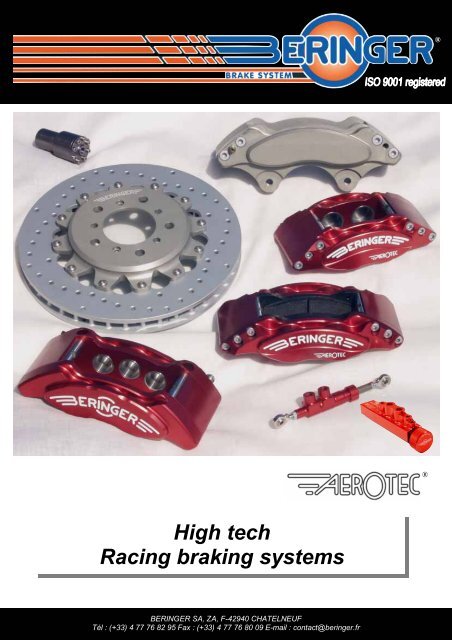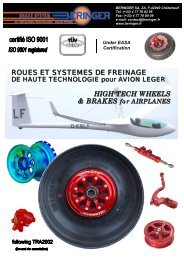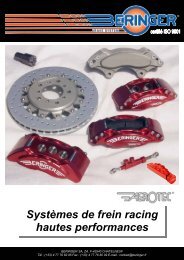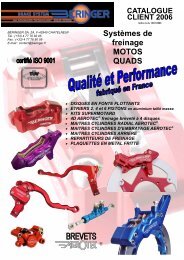High tech Racing braking systems - Beringer.fr
High tech Racing braking systems - Beringer.fr
High tech Racing braking systems - Beringer.fr
Create successful ePaper yourself
Turn your PDF publications into a flip-book with our unique Google optimized e-Paper software.
®<br />
®<br />
<strong>High</strong> <strong>tech</strong><br />
<strong>Racing</strong> <strong>braking</strong> <strong>systems</strong><br />
BERINGER SA, ZA, F-42940 CHATELNEUF<br />
Tél : (+33) 4 77 76 82 95 Fax : (+33) 4 77 76 80 09 E-mail : contact@beringer.<strong>fr</strong>
BMW M3<br />
COMPARATIVE TEST of BRAKING DISTANCES<br />
Average distance reduction at 130 km/h on dry surface<br />
with BMW M3 : 13.7 meters<br />
Braking distance<br />
From 130km/h to 0km/h
M3 AC SCHNITZER kit
DOUBLE DISC SYSTEM<br />
®<br />
F.E.M.<br />
BERINGER brakes are optimized<br />
with a powerfull 3D FEM software<br />
which allows to reach always the<br />
best performance/weight ratio.
MATRA AVANTIME<br />
SPORT
An advanced <strong>tech</strong>nology:<br />
the COMPETITION<br />
2005 Supertourisme French Champion<br />
Mitsubishi Rallye Raid<br />
SEAT<br />
Supertourisme<br />
Renault FR V6<br />
Rallye
An advanced <strong>tech</strong>nology:<br />
the COMPETITION<br />
BERINGER is 2000,2002 and 2003 Endurance World Champion<br />
And 2005 vice World Champion with the Team BOLLIGER<br />
Adrien CHAREYRE<br />
Vice World Champion<br />
SUPERMOTARD<br />
2005 French Champion<br />
Photo Nicolas SEVESTRE<br />
Supermotard :<br />
BERINGER is 2003 and 2004 EUROPEAN Champion and<br />
World vice-champion in 2002 2004 2005
This caliper was developed <strong>fr</strong>om the knowledge acquired <strong>fr</strong>om different competitions in which Béringer has<br />
been involved. Thanks to innovative patents and <strong>tech</strong>nical solutions, this caliper has the advantage of reacting<br />
more quickly (reduction of hysteresis) and not causing slantwise wear of brake pads. Performances are better,<br />
but this is not the only advantage.<br />
Brake pad guides : the<br />
patent<br />
The patented system of chrome-plated guides for the brake pads greatly reduces hysteresis of the<br />
caliper. The brake pads are mounted on supports equipped with two lugs. These lugs slide easily on<br />
the chrome-plated guide bars, even during intensive use under difficult conditions.<br />
Lug<br />
Chrome-plated guide bar<br />
brake pad<br />
connector bar<br />
The brake pads are guided by a system of chrome-plated guide bars placed where<br />
deformation is the lowest, a patented BERINGER system.
patent: why and how ?<br />
An axial effort (the pressure of the piston on the disk) produces a tangent effort (the pressure of the pad on its<br />
stop) caused by the rotation of the disk. This axial effort also causes deformation of the caliper (opening).<br />
On a conventional caliper, we can see <strong>fr</strong>iction between the brake pad and the abutment inside the body. This<br />
<strong>fr</strong>iction, caused by deformation of the caliper, hinders the return of the pad when the brake pressure is released,<br />
causing errors of control.<br />
On Béringer caliper, the tangent effort is produced in a neutral zone where there is no caliper<br />
deformation and the chrome-plated guide bars ease the to-and-<strong>fr</strong>o movement of the brake pads.<br />
Torque in mdaN<br />
17mdaN<br />
In this way (see graph), when pressure is put on the brake pedal,<br />
with a Béringer caliper a torque of 17 mdaN can be obtained with a<br />
pressure of 66 bars, instead of 80 on a standard system.<br />
48 60 80<br />
Pressure in bars<br />
Conventional caliper<br />
Torque in mdaN<br />
17mdaN<br />
When the pedal is released, to obtain these same<br />
17 mdaN, 56 bars are needed with Béringer against<br />
48 with a traditional system: the control error is reduced<br />
to 17% against 53 % before and performance is improved<br />
by 23 %.<br />
56 60 66<br />
Pressure in bars<br />
BERINGER caliper<br />
This is a great advantage as the impression of safety given by a better control of <strong>braking</strong> improves the timing on<br />
the circuit.
No slantwise wear of brake pads:<br />
On a conventional caliper compensation for slantwise wear due to tilting of the pad is traditionally obtained by<br />
pistons of different diameters. But this compensation is:<br />
• insufficient when the pads are new and too great when they are worn ;<br />
• adapted to an average rate of <strong>fr</strong>iction and cannot adapt to pads with a higher or lower rate<br />
Béringer’s unique system of compensation angles optimises slantwise wear, both on new or worn<br />
pads, whether using pads with a high or low rate, as the angle is machined into the pad.<br />
Pads<br />
Compensation<br />
angles<br />
Disc<br />
Reduced dimensions and reinforced safety:<br />
Thanks to the 3D optimisation by finite elements, Béringer was able to reduce the width of the caliper thus<br />
avoiding offsetting the wheel (49 mm for models A, B, D, and E and 52 mm for models C and F).<br />
As the brake fluid passes through a circuit integrated in the body, no hose is needed outside the<br />
caliper, ensuring an exceptional resistance to external damage caused by gravel, stones, etc.<br />
Hydraulic circuit included in the casings for extra<br />
safety: no external hosing<br />
49 to 52 mm<br />
F1 caliper test<br />
Strict tolerances and NC machining of all components cut <strong>fr</strong>om a block ensure accurate dimensions<br />
which limit backlash during movements connected with <strong>braking</strong>.<br />
Computer aided design, 3D calculations, machining on<br />
high-speed NC machines used for aeronautics: complete<br />
mastery <strong>fr</strong>om design to production using state-of-the-art<br />
equipment
Made <strong>fr</strong>om blocks<br />
Béringer uses a high-performance aeronautic<br />
alloy, which is used on the wings of supersonic<br />
fighter planes. The resistance of this alloy is more<br />
than twice that of the original callipers and can be<br />
used in high temperatures.<br />
Résistance Strength élastique in Mpa<br />
400<br />
300<br />
180<br />
140<br />
Aeronautic alloy (<strong>Beringer</strong> caliper)<br />
Alliage aéronautique (étriers BERINGER)<br />
Foundry alloy (conventional caliper)<br />
Alliage de fonderie (étriers d’origine)<br />
0<br />
Temperature<br />
Température °C<br />
200<br />
Machining <strong>fr</strong>om a block on NC machines ensures perfect control of<br />
thickness and a saving of weight <strong>fr</strong>om 30 % to 40 %, compared<br />
with the original callipers. This precision machining is the guarantee<br />
of fine control in the power of <strong>braking</strong>.<br />
Tests of brake pad wear:<br />
After 60,000 km, the slantwise wear on both pads is less than 0.1 mm on a daily used car<br />
and less than 0.4 mm on a racing car !<br />
Results of the different tests<br />
Tests of use in adverse conditions:<br />
Despite the mud and sand, the guide bars continue to operate perfectly and safeguard the<br />
properties of the calliper whatever the conditions.<br />
Improvement of vehicle control with ABS<br />
Official tests on <strong>braking</strong> carried out by UTAC:<br />
These tests were carried out in the real conditions of automobile certification. They proved the effectiveness of<br />
the guide bars and the impact on the ABS operation.<br />
The wheels are locked by a very strong pressure on the brake pads. The ABS system releases the pressure when<br />
this locking occurs so that the tyres regain their adherence and then exerts pressure again so that the vehicle<br />
brakes. During emergency <strong>braking</strong>, there is a succession of to- and <strong>fr</strong>o movements of the brake pads.<br />
Thanks to the patented brake pad guides, the caliper optimises operation of the ABS by unlocking the wheel<br />
more rapidly and limiting the time during which the wheel is locked. On dry ground better control of the vehicle<br />
is seen.<br />
Reduction of <strong>braking</strong> distance on wet roads !<br />
On surfaces where adherence is poor, ABS is particularly necessary. The adherence factor on wet<br />
ground of a moving vehicle is 0.3 (1.1 on dry ground), and only 0.1 when the wheels are locked –<br />
three times less!<br />
The UTAC test showed that for an upmarket sports vehicle equipped with a V6 3.0 l engine and reputable<br />
brakes, the <strong>braking</strong> distance <strong>fr</strong>om 80 to 0 kph on wet ground is reduced by 8.8 metres! Remember that a<br />
pedestrian crossing is 5 meters wide.
LOW HYSTERESIS<br />
PRESSURE LIMITERS<br />
• Plane curve, single circuit<br />
• Plane curve, double circuit<br />
• Proportional curve, single circuit<br />
• Proportional reverser curve, single circuit<br />
May be used<br />
with ABS system
• Plane curve, single circuit<br />
• Plane curve, double circuit<br />
• Proportional curve, single circuit<br />
• Proportional reverser curve, single circuit
Caliper E-E…<br />
6 pistons ∅ 32 mm, disc ∅ 305 to 325 mm.<br />
• total surface of the pistons: 4825 mm 2 .<br />
• height of the pad: 42.4 mm.<br />
• minimum internal diameter of the rim:<br />
• for a disc ∅ 305: 357 mm<br />
• for a disc ∅ 315: 367 mm<br />
• for a disc ∅ 325: 377 mm<br />
• thickness of the pad : 16 mm (minimum 8mm).<br />
• feeding thread : M10x1<br />
Dimensioned drawing of the caliper :<br />
View V<br />
<strong>fr</strong>om the mounting<br />
surface to the top of the<br />
padding: 57.8<br />
M10x1<br />
69.1<br />
∅ 305 to 325<br />
V<br />
∅ 12.2<br />
152<br />
J<br />
J<br />
E<br />
C<br />
C<br />
D<br />
A<br />
B<br />
132.3<br />
132.3<br />
play J (min/<br />
max)<br />
pads<br />
internal half<br />
width C<br />
half width<br />
B<br />
half width<br />
A<br />
offset D<br />
weight<br />
without<br />
pads (kg)<br />
thickness of<br />
the disc (E)<br />
caliper part<br />
n°<br />
E-E-A-- 20 à 23 2.70 40.6 60 60 28.5 1/2.5<br />
E-E-B-- 24 à 27 2.75 42.6 62 62 30.5 1/2.5<br />
E-E-C-- 27 à 30 2.75 44.1 63.5 63.5 32 1/2.5<br />
E-E-F-- 29 à 32 2.75 45.1 64.5 64.5 33 1/2.5<br />
E-E-D-- 32 à 35.5 2.80 46.85 66.25 66.25 34.75 1/2.75
Caliper F-F…<br />
6 pistons ∅ 32 mm, disc ∅ 335 to 355 mm.<br />
• total surface of the pistons: 4825 mm 2 .<br />
• height of the pad: 45.7 mm.<br />
• minimum internal diameter of the rim:<br />
• for a disc ∅ 335: 387 mm<br />
• for a disc ∅ 345: 397 mm<br />
• for a disc ∅ 355: 407 mm<br />
• thickness of the pad : 16 mm (minimum 8mm).<br />
• feeding thread : M10x1.<br />
Dimensioned drawing of the caliper :<br />
View V<br />
<strong>fr</strong>om the mounting<br />
surface to the top of the<br />
padding: 58.8<br />
M10x1<br />
65.1<br />
∅ 335 to 355<br />
V<br />
∅ 12.2<br />
180<br />
J<br />
J<br />
E<br />
C<br />
C<br />
D<br />
B<br />
A<br />
144.3<br />
144.3<br />
play J (min/<br />
max)<br />
pads<br />
internal half<br />
width C<br />
half width B<br />
half width A<br />
offset D<br />
weight without<br />
pads (kg)<br />
thickness of the<br />
disc (E)<br />
caliper part n°<br />
F-F-A-- 20 à 23 3.05 40.6 63 63 28.5 1/2.5<br />
F-F-B-- 24 à 27 3.10 42.6 65 65 30.5 1/2.5<br />
F-F-C-- 27 à 30 3.10 44.1 66.5 66.5 32 1/2.5<br />
F-F-F-- 29 à 32 3.10 45.1 67.5 67.5 33 1/2.5<br />
F-F-D-- 32 à 35.5 3.15 46.85 69.25 69.25 34.75 1/2.75
Caliper F3…<br />
4 pistons ∅ 38 mm, disc ∅ 278 mm.<br />
• total surface of the pistons: 4536 mm 2 .<br />
• height of the pad: 42.5 mm.<br />
• minimum internal diameter of the rim: 325mm<br />
• thickness of the pad : 14 mm (minimum 8mm).<br />
• feeding thread : M10x1<br />
• it is possible with discs of width>10 with other bridges (new guides would be necessary)<br />
Dimensioned drawing of the caliper :<br />
<strong>fr</strong>om the mounting<br />
surface to the top<br />
of the padding:<br />
View V<br />
V<br />
J<br />
E<br />
J<br />
C<br />
C<br />
D<br />
A<br />
B<br />
play J (min/max)<br />
pads<br />
internal half<br />
width C<br />
half width B<br />
half width A<br />
offset D<br />
weight without<br />
pads (kg)<br />
thickness of the<br />
disc (E)<br />
caliper part n°<br />
M-M-K-- 16 1.54 40 58.5 57.5 23 1 / 2.5
Caliper H-H…<br />
4 pistons ∅ 38 mm, disc ∅ 335 to 355 mm.<br />
(entraxe 180)<br />
• total surface of the pistons: 4536 mm 2 .<br />
• height of the pad: 45.7 mm.<br />
• minimum internal diameter of the rim:<br />
• for a disc ∅ 335: 387 mm<br />
• for a disc ∅ 345: 397 mm<br />
• for a disc ∅ 355: 407 mm<br />
• thickness of the pad : 16 mm (minimum 8mm).<br />
• feeding thread : M10x1.<br />
Dimensioned drawing of the caliper :<br />
View V<br />
<strong>fr</strong>om the mounting<br />
surface to the top of the<br />
padding: 58.8<br />
M10x1<br />
65.1<br />
∅ 335 to 355<br />
V<br />
∅ 12.2<br />
180<br />
J<br />
J<br />
E<br />
C<br />
C<br />
D<br />
B<br />
A<br />
144.3<br />
144.3<br />
play J (min/<br />
max)<br />
pads<br />
internal half<br />
width C<br />
half width B<br />
half width A<br />
offset D<br />
weight<br />
without pads<br />
(kg)<br />
thickness of<br />
the disc (E)<br />
caliper part<br />
n°<br />
H-H-A-- 20 à 23 3.05 40.6 63 63 28.5 1/2.5<br />
H-H-B-- 24 à 27 3.10 42.6 65 65 30.5 1/2.5<br />
H-H-C-- 27 à 30 3.10 44.1 66.5 66.5 32 1/2.5<br />
H-H-F-- 29 à 32 3.10 45.1 67.5 67.5 33 1/2.5<br />
H-H-D-- 32 à 35.5 3.15 46.85 69.25 69.25 34.75 1/2.75
Caliper I-I…<br />
6 pistons Æ 32 mm, disc Æ 365 to 380 mm.<br />
• total surface of the pistons: 4825 mm 2 .<br />
• height of the pad: 45.7 mm.<br />
• minimum internal diameter of the rim:<br />
• for a disc ∅ 365: 417 mm<br />
• for a disc ∅ 375: 427 mm<br />
• for a disc ∅ 380: 432 mm<br />
• thickness of the pad : 16 mm (minimum 8mm).<br />
• feeding thread : M10x1.<br />
Dimensioned drawing of the caliper<br />
View V<br />
<strong>fr</strong>om the mounting<br />
surface to the top of the<br />
padding: 58.8<br />
M10x1<br />
65.5<br />
∅ 365 to 380<br />
V<br />
∅ 12.2 180<br />
J<br />
J<br />
E<br />
C<br />
C<br />
D<br />
B<br />
A<br />
145.7<br />
145.7<br />
play J (min/max)<br />
pads<br />
internal half<br />
width C<br />
half width B<br />
half width A<br />
offset D<br />
weight without<br />
pads (kg)<br />
thickness of the<br />
disc (E)<br />
caliper part n°<br />
I-I-A-- 20 à 23 3.35 40.6 63 63 28.5 1/2.5<br />
I-I-B-- 24 à 27 3.40 42.6 65 65 30.5 1/2.5<br />
I-I-C-- 27 à 30 3.40 44.1 66.5 66.5 32 1/2.5<br />
I-I-F-- 29 à 32 3.40 45.1 67.5 67.5 33 1/2.5<br />
I-I-D-- 32 à 35.5 3.45 46.85 69.25 69.25 34.75 1/2.75
Caliper J-H…<br />
4 pistons ∅ 38 mm, disc ∅ 335 to 355 mm.<br />
(entraxe 152)<br />
• total surface of the pistons: 4536 mm 2 .<br />
• height of the pad: 45.7 mm.<br />
• minimum internal diameter of the rim:<br />
• for a disc ∅ 335: 387 mm<br />
• for a disc ∅ 345: 397 mm<br />
• for a disc ∅ 355: 407 mm<br />
• thickness of the pad : 16 mm (minimum 8mm).<br />
• feeding thread : M10x1.<br />
Dimensioned drawing of the caliper :<br />
View V<br />
<strong>fr</strong>om the mounting<br />
surface to the top of the<br />
padding : 58.8<br />
M10x1<br />
65.1<br />
∅ 335 to 355<br />
V<br />
∅ 12.2 152<br />
J<br />
J<br />
E<br />
C<br />
C<br />
D<br />
A<br />
B<br />
144.3<br />
144.3<br />
play J (min/max)<br />
pads<br />
internal half<br />
width C<br />
half width B<br />
half width A<br />
offset D<br />
weight without<br />
pads (kg)<br />
thickness of the<br />
disc (E)<br />
caliper part n°<br />
J-H-A-- 20 à 23 3.05 40.6 63 63 28.5 1/2.5<br />
J-H-B-- 24 à 27 3.10 42.6 65 65 30.5 1/2.5<br />
J-H-C-- 27 à 30 3.10 44.1 66.5 66.5 32 1/2.5<br />
J-H-F-- 29 à 32 3.10 45.1 67.5 67.5 33 1/2.5<br />
J-H-D-- 32 à 35.5 3.15 46.85 69.25 69.25 34.75 1/2.75
Caliper M-M…<br />
4 pistons ∅ 38 mm, disc ∅ 260 to 290 mm.<br />
• total surface of the pistons: 4536 mm 2 .<br />
• height of the pad: 42.5 mm.<br />
• minimum internal diameter of the rim:<br />
• for a disc ∅ 260: 312 mm<br />
• for a disc ∅ 275: 327 mm<br />
• for a disc ∅ 290: 342 mm<br />
• thickness of the pad : 16 mm (minimum 8mm) except for M-M-K-: 14mm (minimum 7mm).<br />
• feeding thread : M10x1<br />
Dimensioned drawing of the caliper :<br />
View V<br />
<strong>fr</strong>om the mounting<br />
surface to the top of the<br />
padding: 49.5<br />
M10x1<br />
59.3<br />
∅ 260 to 290<br />
V<br />
∅ 10.2<br />
120<br />
J<br />
J<br />
E<br />
C<br />
C<br />
D<br />
A<br />
B<br />
112.8<br />
112.8<br />
caliper<br />
part n°<br />
thickne<br />
ss of<br />
the disc<br />
(E)<br />
weight<br />
without<br />
pads<br />
(kg)<br />
offset<br />
D<br />
half<br />
width<br />
A<br />
half<br />
width B<br />
internal<br />
half<br />
width C<br />
M-M-K-- 16 1.80 40 58.5 57.5 23 1<br />
M-M-L-- 17 à 22 1.90 45 63.5 62.5 28 1/3.5<br />
M-M-J-- 23 à 28 1.90 48 66.5 65.5 31 1/3.5<br />
pads<br />
play J<br />
(min/max)
Caliper Q-Q (super 1600)…<br />
4 pistons ∅38 mm, disc ∅295 to 355 mm.<br />
• total surface of the pistons: 4536 mm 2 .<br />
• height of the pad: 42.5 mm.<br />
• minimum internal diameter of the rim:<br />
• for a disc ∅ 355: 410 mm<br />
• for a disc ∅ 295: 360 mm<br />
• thickness of the pad : 16 mm (minimum 8mm).<br />
• feeding thread : M10x1.<br />
Dimensioned drawing of the caliper :<br />
<strong>fr</strong>om the<br />
mounting<br />
surface to the<br />
View V<br />
180<br />
M12<br />
Ø295 to 355<br />
V<br />
play J (min/<br />
max)<br />
pads<br />
internal half<br />
width C<br />
half width B<br />
half width A<br />
offset D<br />
weight without<br />
pads (kg)<br />
thickness of the<br />
disc (E)<br />
caliper part n°<br />
Q-Q-K-- 32 2.05 42.7 65.5 65.5 31 1/2.5<br />
Q-Q-M-- 36 2.07 44.7 67.5 67.5 33 1/2.5
Caliper R-R…<br />
4 pistons ∅ 32 mm, disc ∅ 260 to 290 mm.<br />
• total surface of the pistons: 3217 mm 2 .<br />
• height of the pad: 42.5 mm.<br />
• minimum internal diameter of the rim:<br />
• for a disc ∅ 260: 312 mm<br />
• for a disc ∅ 275: 327 mm<br />
• for a disc ∅ 290: 342 mm<br />
• thickness of the pad : 14 mm (minimum 7mm)<br />
• feeding thread : M10x1<br />
• it is possible with discs of width>10 with other bridges (new guides would be necessary)<br />
Dimensioned drawing of the caliper :<br />
View V<br />
<strong>fr</strong>om the mounting<br />
surface to the top<br />
of the padding.<br />
125.2<br />
M10<br />
V<br />
D<br />
A<br />
J<br />
E<br />
J<br />
C<br />
B<br />
play J (min/max)<br />
pads<br />
internal half<br />
width C<br />
half width B<br />
half width A<br />
offset D<br />
weight without<br />
pads (kg)<br />
thickness of the<br />
disc (E)<br />
caliper part n°<br />
R-R-N-- 6.5 à 10 1.58 30.5 55.25 54.25 19.75 0.75/2.5
Master cylinder ∅12.7<br />
• Part n°: MC12.7<br />
• diameter of the piston: 12.7 mm.<br />
• Piston stroke : 20 mm.<br />
• thread type of the connectors (same type for feeding and output): M10x1.<br />
• diameter of the ball-end bores: 6 mm ball-end with needle bearing are available).<br />
• ball-end rod: M6x0.8 (male).<br />
Piston stroke : 22mm<br />
Master cylinder ∅15.9 to ∅25.4<br />
• Piston stroke : 23 mm.<br />
• thread type of the connectors (same type for feeding and output): M10x1.<br />
• diameter of the ball-end bores: 8 mm ball-end with needle bearing are available).<br />
• ball-end rod: M8x1.25 (male).<br />
100<br />
27.5-30<br />
H<br />
24<br />
Piston stroke : 22mm<br />
24-30<br />
∅<br />
9<br />
∅12.4<br />
∅24<br />
∅14<br />
∅16<br />
12<br />
24<br />
26 M 10x1<br />
10<br />
∅8H7<br />
Référence MC15.9 MC17.5 MC19 MC20.6 MC22.2 MC23.8 MC25.4<br />
Piston diameter 15.9 17.5 19 20.6 22.2 23.8 25.4<br />
∅ 31 31 31 31 31 34 34<br />
H 23.6 24.4 25.1 25.9 26.7 27.5 28.4





